by Lisa Cooke | Apr 9, 2016 | 01 What's New, Source Citation, Trees
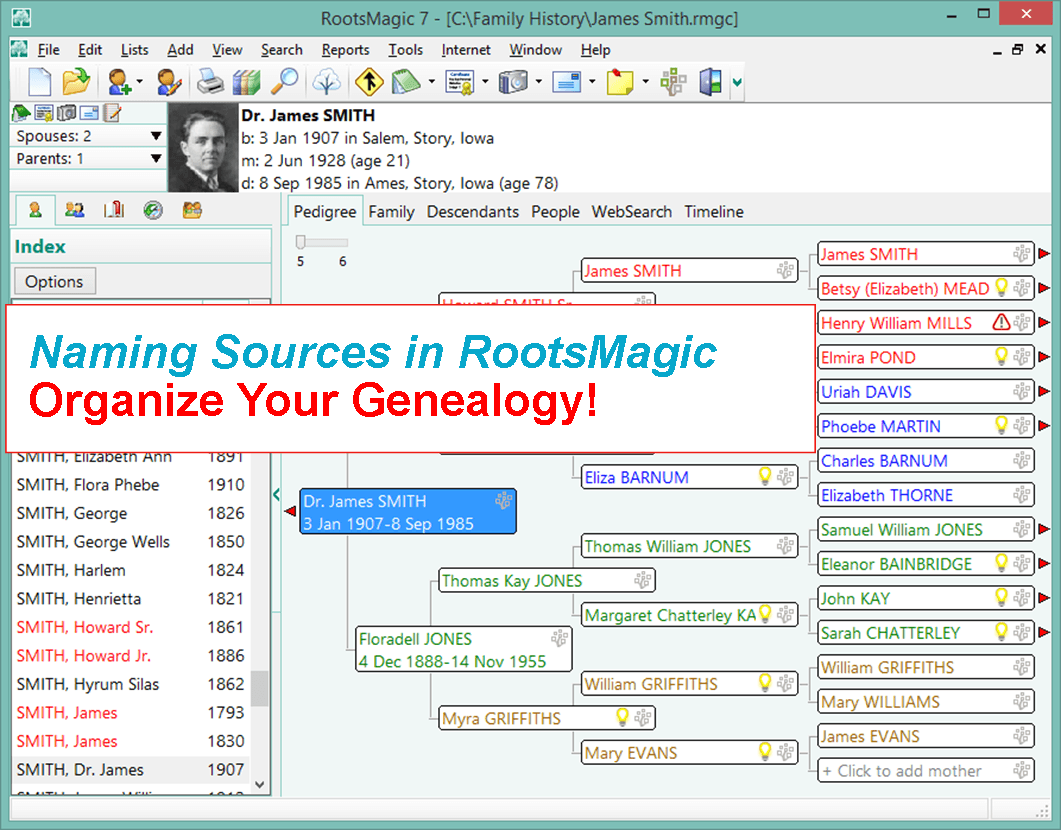
How to name sources in RootsMagic 7 is a matter of personal preference. My preference? Simply and consistently!
Helen recently transitioned from Mac Family Tree 7 to RootsMagic 7. She sent me this question about how to name sources in RootsMagic:
“I stripped out all sources from my old file before exporting the GEDCOM because I wanted to start fresh with a consistent system in RootsMagic 7. I have watched their webinars for sourcing and understand the basic how-to. I’d love to hear your strategy for naming your sources… say census records. If the names are too general, then you have a lot of data entry for each incident. But if the name is too specific, your source list gets very long very quickly. Do you add ID numbers to your sources?
Thanks to Helen for the question! Naming your sources in RootsMagic is really a personal preference, so the first rule of thumb is not so much about what you call them, but rather that you do so consistently. If you have a naming convention that you follow that works, having a very long list won’t be as intimidating.
I used to number my sources long ago in my old database software. Actually that software did it automatically which I really liked, mainly because I put that number in the name of the digital file for the corresponding record image. RootsMagic 7 allows us to attach our images, so that is no longer an issue.
Here’s an example of my simple approach to naming sources:
Record type > Year > Surname > First name (head of household)
Example: Census 1940 Moore Jay Bee
This way, all census records are grouped together in the source list. The date gives me a time frame of reference (i.e. it is Jay Bee Moore my grandfather rather than his grandfather), Surname, then head of households first name.
If the source is about Jay Bee himself, it works. The source may also mention his wife Pauline, and his son Ronald, but I don’t need to take up space including all of those name in the file name. I know that if I need a source for where Pauline was in 1940, I would find her under her husband Jay Bee. This mirrors my hard drive organization methodology, which I teach in my Genealogy Gems Premium videos.
What if there’s another related family on the same page of that census? This is where personal preference comes in. I save that same census page to the other family’s surname folder on my computer as well. Yes, it is a duplication (and I rarely duplicate effort), but in this case it works for me and I’m consistent. I find it fits better with my hard drive organization, and saves me time down the road when I’m working with a particular family. I could have named the source “Census 1940 Kings Co CA ED16-20 p6,” which is indeed one single unique page of that census but that just isn’t as helpful to me later for retrieval.
Remember, these are your sources, and you can do with them as you please. You are the only one who will be working with them. Again, I’m sharing a process that works well for me. And I always keep my eyes open for new and better ways to do things like this, but even when I find them, I weigh them against the question, “Do I really want to invest the time in changing this that I would have invested in research?” Usually the answer is “No!” unless my way has a proven flaw that will cause me more grief in the end.
There are lots of other ways to do it out there. You know me, I often turn to Google for answers. If you have a question, chances are someone out there has had it too. Google can help you quickly tap into answers. A Google search of how to name sources in Rootsmagic leads to a web page called Organizing Source Names in RM5. It’s a discussion forum where someone posted a similar question. There are a couple of very viable options offered and great discussion about how to decide what works for you. This is one reason I like and recommend RootsMagic, which is a sponsor of the free Genealogy Gems podcast–because they provide so many helpful tutorials with their software. Another great resource is a blog series by Randy Seaver (click the label “RootsMagic”) on how to enter a new source and create a citation.
More Gems on Family History Software
Keeping Up with Online and Master Family Trees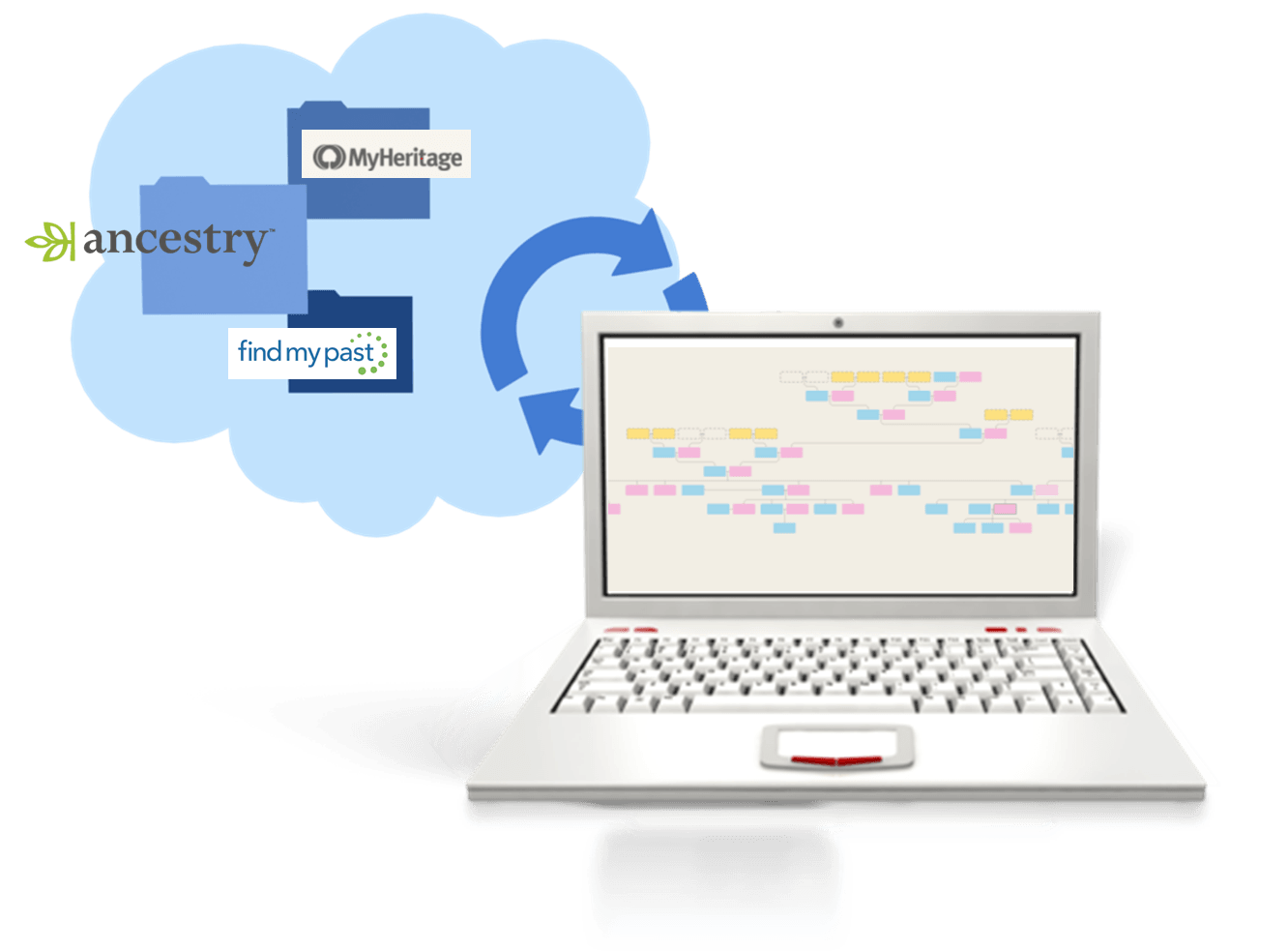
“Is That Software Expired?” Why I Wouldn’t Use Obsolete Family Tree Maker Software
How to Download and Backup Your Ancestry Data: Why To Keep Your Master Tree at Home
by Lisa Cooke | Apr 7, 2016 | 01 What's New, Conferences
Genealogy Gems is coming to OGS 2016! Lisa Louise Cooke will give 3 lectures at the Ohio Genealogical Society conference on April 28-30, 2016, just north of 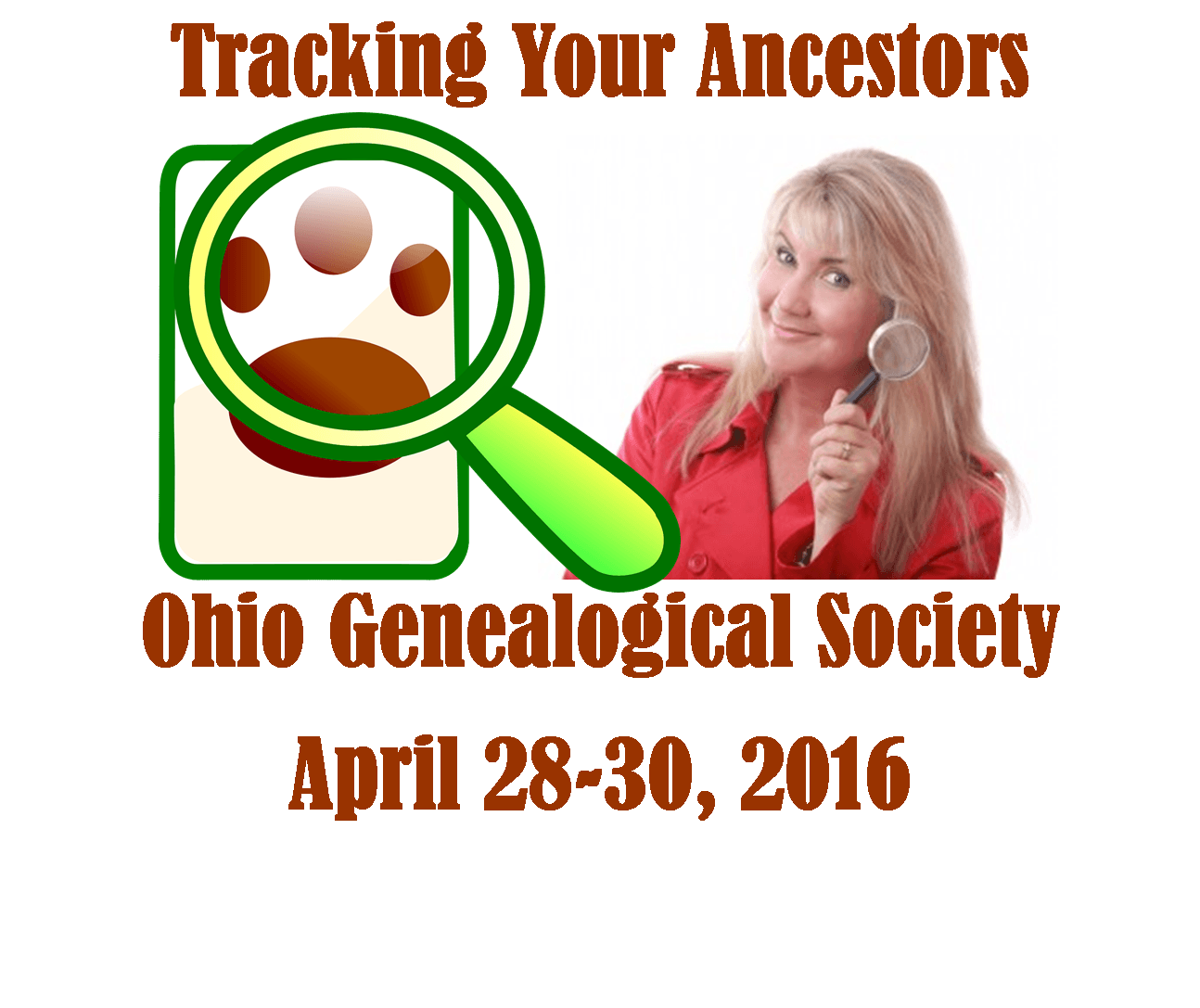 Cincinnati, Ohio.
Cincinnati, Ohio.
The Ohio Genealogical Society is known for attracting scores of nationally-ranked speakers to its annual conference, and this year is no different. Lisa Louise Cooke will be delivering three of her most popular lectures on Thursday and Friday:
- Finally! A Methodology for Using Google for Genealogy
- How to Turn Your Tablet & Smartphone into Genealogy Powerhouses!
- Cool Tools for Online (and Offline) Newspaper Research
These classes bring you cutting-edge online research strategies with Lisa’s signature brand of fresh and fun. You’ll walk away with tools you can use NOW. She often hears the very next day from folks who have tried something new they learned in one of Lisa’s classes and have broken through a brick wall!
WHAT: Ohio Genealogical Society Annual Conference
WHEN: April 28-30, 2016
WHERE: Great Wolf Lodge, Mason, OH (just north of Cincinnati)
REGISTER: Click here for full conference information

Stop by and talk to us about books, family history and whatever’s on your mind!
I’m speaking at OGS 2016, too! My lectures are:
- 12 Ways to Facebook Your Family History
- Find Your Family in Catholic Church Records
- Lies, Errors and Bias—Oh, My! Consider Your Sources
Lisa’s daughter Lacey Cooke, now Genealogy Gems’ full-time Sales Manager, will be at OGS 2016, also. We all hope you’ll stop by the Genealogy Gems booth in the vendor hall to say hello! Meeting Gems listeners and readers is one of our favorite things about attending conferences.
Can’t make it to OGS 2016? Lisa has published books on each one of the topics she’s covering that day! Click on the images below to check them out:
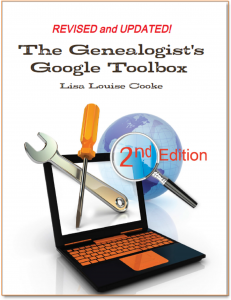
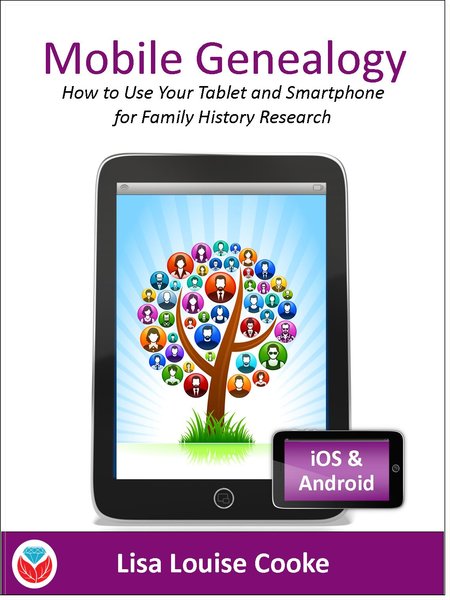

Available at http://genealogygems.com
by Lisa Cooke | Apr 6, 2016 | 01 What's New, Beginner, Research Skills
These 4 tips for courthouse research will help you get the most out of your searches for U.S. courthouse records.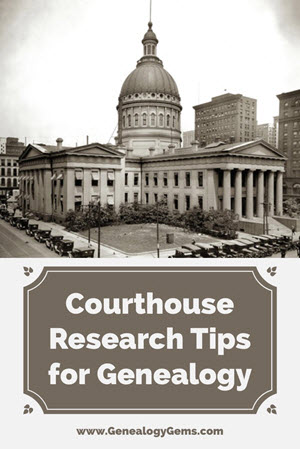
Finding your family history in a county courthouse can be a real thrill. But courthouses can be a little…overwhelming. Confusing. Intimidating. And frustrating, if you feel like you’re wasting the little bit of time you have there. So check out these four tips for getting the most out of your next trip to the courthouse!
1. Know what questions you hope to answer.
What specifically do you hope to learn at the courthouse? Examples of answers you want might be: “I want to identify every child this couple had, I want to determine which years they lived here, I want to know more about land they owned, I want to confirm vital events for these three people, I heard there was a scandal and I want to know if there are court records.” These are the kinds of questions you might successfully research at a courthouse.
2. Learn what resources exist to answer those questions.
Several different kinds of courthouse records can answer our genealogical questions: vital records, deeds, tax records, and wills, probate or estate records, tax or plat maps, road and survey books and more.
Dig around on county offices websites to see what records are at the courthouse. Watch for mention of or links to older records that may no longer be in the offices. Also, Google the name of the county and the word “archives” and see if there is an official archive. After you’ve done some online research, call the appropriate county office (Recorder, Probate, etc) with your remaining questions. Like, what vital or property records exist for a certain time period, or are there delayed birth records, etc.
3. Read up on using complicated record types before you go.
Usually we are pressed for time when we’re researching on-site. Don’t waste that time learning what grantor and grantee indexes are, the differences between different types of deeds, or what a letter of administration is. Learn these ahead of time.
The best way to do that is with some focused tutorials and classes. You can teach yourself what various types of documents look like by browsing them on your favorite genealogy website or by indexing (click here to read about different indexing opportunities). But these self-guided record tours won’t teach you the ins and outs of working with and understanding these records.
4. Learn what you can on the spot.
Once you find something with your ancestor’s name on it at the courthouse, of course you’ll be thrilled! Don’t just make a copy and tuck it away. Try to digest and interpret what it tells you. Follow up whatever you learn in that document, because maybe it brings up another question you can answer while you’re still there. This is another reason it pays to be prepared before you head to the courthouse–so again, learn all you can before you go.
 Thanks for sharing these practical tips with your genealogy friends and on your society Facebook pages. It’s easy, it’s free and you may help someone else learn a much-needed skill! YOU are a gem!
Thanks for sharing these practical tips with your genealogy friends and on your society Facebook pages. It’s easy, it’s free and you may help someone else learn a much-needed skill! YOU are a gem!
Disclosure: This article contains affiliate links and Genealogy Gems will be compensated if you make a purchase after clicking on these links (at no additional cost to you). Thank you for supporting Genealogy Gems!
by Lisa Cooke | Apr 2, 2016 | 01 What's New, Genealogy TV, Who Do You Think You Are?

It’s time for a new season of Who Do You Think You Are? here in the U.S. Episode one features comedian and actress Aisha Tyler (Archer, Ghost Whisper.)
According to TLC, Aisha “tracks down her 2x great-grandfather, whose story had been lost over generations, and uncovers an astonishing tale of a prominent ancestor whose struggle to keep his illegitimate son a secret made headlines.”
The new season of Who Do You Think You Are? premieres Sunday, April 3 at 9/8c
The contributors featured in the upcoming season include:
- Scott Foley finds a relative who risked his life for one of America’s founding fathers, and an ancestor who suffered unspeakably during one of this nation’s darkest times.
- Lea Michele nails down where her mysterious paternal ancestors came from, and learns of the dire economic circumstances they endured while trying to emigrate to the U.S.
- Chris Noth learns his ancestors suffered during one of the greatest catastrophes in American history, and a relative who fought in one of the bloodiest battles of all time.
- Molly Ringwald explores family lore of Swedish royalty which uncovers her ancestors’ harrowing lives and a brave woman who forever changed her family’s fate.
- Katey Sagal is shocked to learn of her family’s Amish roots, and digs deeper as she realizes the level of dedication to their faith.
by Lisa Cooke | Apr 1, 2016 | 01 What's New, Records & databases
Here’s our weekly roundup of new genealogy records online. This week: Australia, Belgium, Czech Republic, England, Germany, Japan, Mexico, Wales and U.S. passport 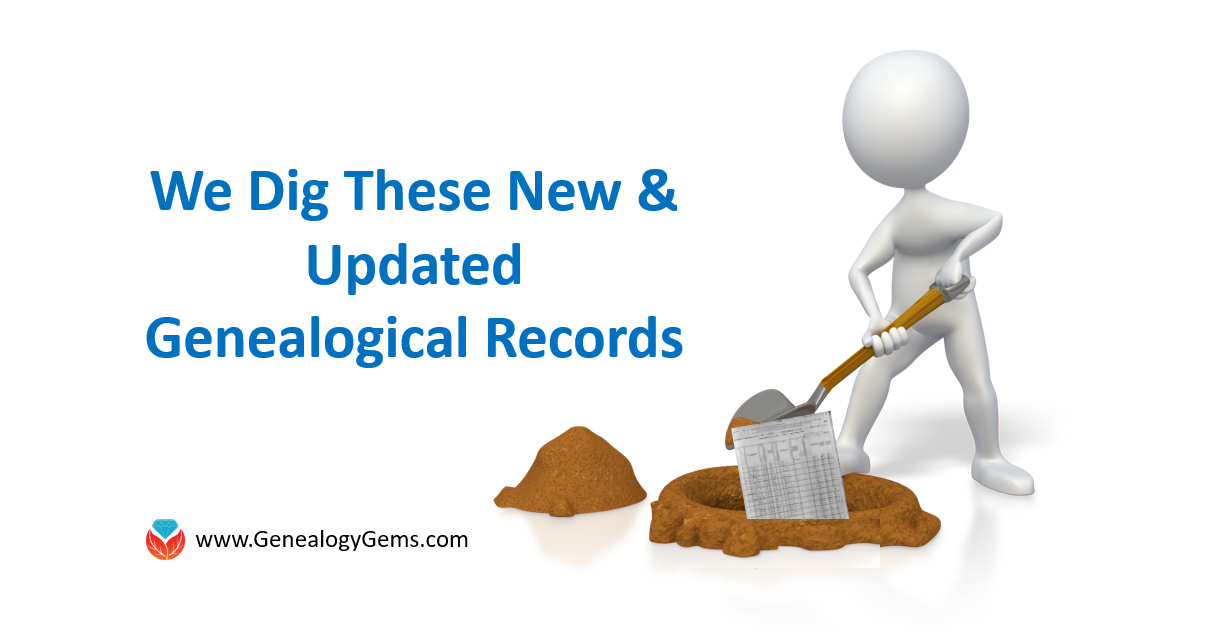 and homestead records.
and homestead records.
AUSTRALIA – QUEENSLAND. Ancestry.com has added several indexes for Queensland, Australia: Prison and Reformatory Indexes (1824-1936), Property Indexes (1842-1895), Index to Aliens (1913) and Occupational Indexes (1857-1922). These indexes all come from the Queensland State Archives. You can search them for free at Ancestry.com or from the QSA website.
BELGIUM CIVIL REGISTRATIONS. FamilySearch has updated its civil registration collections for several parts of Belgium (dating back to the 1500s for some areas): Antwerp, Brabant, East Flanders, Hainaut, Liège and West Flanders. According to FamilySearch, these collections include “civil registration(s) of births, marriages and deaths from the Belgium National Archives. The collection also includes marriage proclamations, marriage supplements, and some original indexes.”
CZECH REPUBLIC SCHOOL REGISTERS. Over a million browsable digital images from the Opava State Regional Archive have been added to a free collection of Czech Republic School Registers (1799-1953) at FamilySearch.org. “School registers contain the full name for a child, birth date, place of birth, country, religion and father’s full name, and place of residence.”
ENGLAND AND WALES SCHOOL RECORDS. Findmypast.com has just added about 687,000 new school admission records for 41 counties in England and Wales (1870-1914). Original records may include names, residence, birth data, school name and location, parents’ names, admission information, father’s occupation, any exemption from religious instruction, previous school attendance, illnesses/absence and even exam results.
ENGLAND – CORNWALL. Several new collections on Cornwall are searchable at Ancestry.com: Congregational and Baptist Church Registers (1763-1923), Workhouse Admission and Discharge Records (1839-1872), Militia and Sea Fencibles Index (1780 – 1831), Bodmin Gaol Records (1821-1899), Penzance Dispensary Admissions (1828-1841), Truro Police Charge Books (1846-1896) and Inmates at St. Lawrence’s Asylum, Bodmin (1840-1900).
GERMANY VITAL RECORDS. Ancestry.com has recently added a new collection of death records for Mannheim. It has also updated collections of birth records for Hamburg; birth, marriage and death records for Regen County (dating to 1876) and birth, marriage and death records for Oldenberg.
JAPAN GENEALOGIES AND VILLAGE RECORDS. FamilySearch.org has added nearly a quarter million browsable images to its collection of Japanese village records (dating back to 709 AD) and nearly 60,000 browsable records to its collection of Japanese genealogies (dating to 850 AD).
MEXICO CIVIL REGISTRATIONS. Ancestry.com has updated its collections of indexed images to Chihuahua, Mexico birth, marriage and death records from civil registrations. The collections are in Spanish, so use Spanish names and locations.
U.S. HOMESTEAD RECORDS. Ancestry.com’s collection of U.S. Homestead Records (1861-1936) has recently been updated. According to the collection description, “Homestead files consist of unbound documents that include final certificates, applications with land descriptions, affidavits showing proof of citizenship, register and receiver receipts, notices and final proofs, and testimonies of witnesses. These documents are part of the Records of the Bureau of Land Management (formerly known as the General Land Office), Record Group (RG) 49. The collection currently includes records from Arizona, Indiana, Nebraska, Nevada, Ohio, and part of Iowa. Additional records will be added in future updates.”
U.S. PASSPORTS. Nearly 40,000 indexed names have been added to FamilySearch.org’s free collection of United States Passport Applications (1795-1925). These are a fantastic resource for finding immigrant ancestors and those who traveled a lot. Click here to learn more about U.S. passport records.

Thanks for sharing this post with others who have ancestors from these parts of the world. You’re a gem!



 Cincinnati, Ohio.
Cincinnati, Ohio.




 Thanks for sharing these practical tips with your genealogy friends and on your society Facebook pages. It’s easy, it’s free and you may help someone else learn a much-needed skill! YOU are a gem!
Thanks for sharing these practical tips with your genealogy friends and on your society Facebook pages. It’s easy, it’s free and you may help someone else learn a much-needed skill! YOU are a gem!
 and homestead records.
and homestead records.


